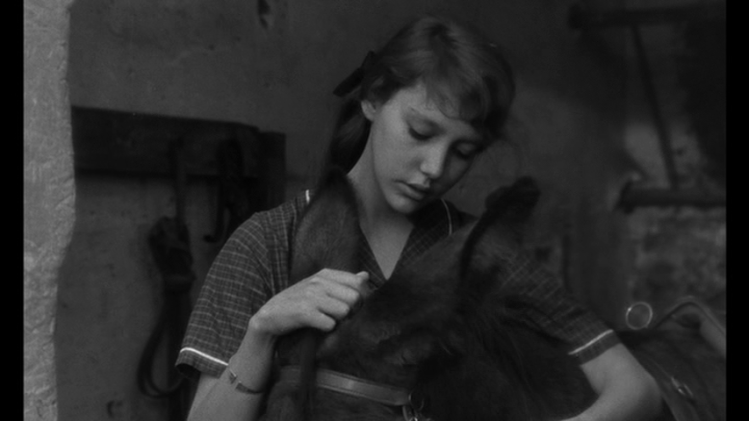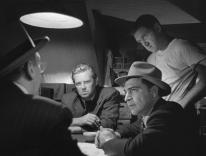
The December 1999 death of Robert Bresson at the age of ninety-two represents the virtual end of the post-World War II era of internationally known film directors. Although Bresson never found the broad audience that made Ingmar Bergman and Federico Fellini household names, his reputation among movie professionals—Jean-Luc Godard called him "the Mozart of French cinema"—guarantees that his work will continue to be studied, especially by aspiring directors. And Bresson’s axiom that "the supernatural is only the real brought close up" suggests an additional reason to arrange retrospectives of his films and look at them more closely.
The relationship between movies and religion can be a treacherous one, often exploited by well-intentioned pastors looking to illustrate their sermons or teachers of religious studies, hoping to increase class enrollment. Bresson’s work doesn’t lend itself to such purposes. He is as little interested in conveying pious messages as in replicating surface realism; he wants the viewer to discover the interior meaning of the images he has arranged. He is known in the United States as the director of Diary of a Country Priest (1950). An examination of Bresson’s stylistic decisions shows how he transformed Georges Bernanos’s classic but apparently unfilmable novel into a credible and deeply affecting movie.
Despite the critical success of his first two films, The Angels of Sin (1943) and The Ladies of the Bois de Boulogne (1944), Bresson decided to break with the conventions of French film production in preparing Diary for the screen. He chose unknown actors, with little or no experience. Instead of using artificial sets, he shot the movie in a village in the Pas-de-Calais, and he avoided all spectacle and melodrama. Claude Laydu became so identified with the role as the young curé d’Ambricourt that he virtually disappeared from movies afterward. Disciplined by Bresson almost to the point of playing an automaton, Laydu said he did not realize that he had been portraying a saint until he saw the completed film. Bresson is faithful to the Bernanos text-all the dialogue in the movie is taken from the novel—but the director’s style is quite different.
While Bernanos is often lyrical, highly visual, and dramatic, the film opens simply, showing the school notebook in which the curé is making an entry. We hear his voice as he rereads it: "I don’t think I am doing wrong in jotting down, day by day, with absolute frankness, the very simple trivial secrets of a very ordinary kind of life." Throughout the film, the curé’s voice either echoes the text as he makes his diary entries, or prolongs it in subsequent images. While it would seem redundant to repeat what the images already reveal, such doubling assures an intensification; there is a constant going and coming between the external and the internal world. Sometimes the voice pronouncing the words of the journal covers over those being spoken by the curé, who is heard again only when the journal’s voice has become silent.
This occurs in the film’s key scene, when the curé challenges the local countess on her long-stored sense of personal bitterness. "Have you heard me?" she demands. He says no, and we haven’t either, because for a moment the voice of the journal is the only one that is audible. On such occasions, leaving ordinary duration for a domain beyond time, we enter the realm of inner consciousness. The supreme instance of this technique is an exchange between the young curé and his mentor, the curé de Torcy, when the older man insists that we all have to find the place in the gospel where we personally encounter Jesus. Suddenly Torcy exclaims: "What on earth’s the matter? What are you blubbering about?" There is a close-up of the young priest’s face as Torcy’s words are covered by the voice of the journal: "I hadn’t realized that I was weeping." A tear rolls down the young curé’s cheek as the voice continues: "The truth is that my place for all time has been the Garden of Olives." After a medium shot of the two priests, Torcy continues: "What’s up now? You’re not even listening to me; are you dreaming?" Again the interior voice: "Suddenly our Lord had granted me the grace of letting me know, through the words of my old teacher...that I was the prisoner of his sacred Passion." Bresson makes these words more poignant by avoiding any dramatic emphasis; we hear the barking of a dog, and the camera’s gradual withdrawal returns us to the world of appearances.
Diary of a Country Priest is a prime example of Bresson’s rigor; he eliminated almost a third of the finished film in a final cut for the exhibitors’ copy. There is an absence of psychology, which French films had prided themselves on, and practically no character development; each scene is complete in itself, as if controlled by some law of necessity. Bresson’s love of abstraction is accompanied by a sure instinct for the telling concrete detail. When the curé falls in the mud, Seraphita, his precocious catechism student, gives him a cloth to wipe his face; during the conversation with the countess, we hear the raking of paths in the park; and visuals of doors and grills underline the relationship between people and things. Bresson makes it easy for agnostics to explain the actions of the curé as the result of heredity and morbidity, and the pious may feel cheated by the director’s refusal to edify. His very restraint, however, forces viewers to give Diary their closest attention. Film critic and theorist André Bazin’s praise is well earned: "Probably for the first time, the cinema gives us a film in which the only genuine incidents, the only perceptible movements, are those of the life of the spirit. It also offers us a new dramatic form that is specifically religious-or better still, specifically theological; a phenomenology of salvation and grace."
Man Escaped (1956), Bresson’s next movie (the French title is A Man Condemned to Death Escaped), is an even clearer demonstration that the "spiritual" aspect of his work emerges from style rather than subject matter. When I took my then-fifteen-year-old son to see the film, he was hardly interested in the religious subtext but found the movie far more "real" than the thrillers to which he was accustomed. Although the story is based on the real-life escape of André Devigny (renamed Fontaine in the movie) from the Nazi prison of Montluc in Lyon in 1943, Bresson’s intentions were very different from those of the Italian neorealists. "I wanted all the factual details to be exact," he said, "but at the same time I tried to get beyond basic realism...I was hoping to make a film about objects which would at the same time have a soul. That is to say, to reach the latter through the former."
Bresson tells us nothing of the prisoner’s activities in the French Resistance, but shots of his face show intelligence, determination, and self-control. The camera observes his hands intently as they patiently scrape away the joints of his cell door, using an iron spoon he has bent into a chisel. The movie’s title seems to eliminate suspense, but by concentrating on the details of prison life and avoiding melodramatic effects, Bresson brings us close to Devigny’s actual experience and encourages us to reflect on the significance of imprisonment and liberation.
A Man Escaped is made up of innumerable, quick-moving fragments; there are 600 shots but no extended sequences. "It was a matter," Bresson said, "of making a rapid film with slow things, suggesting the heavy life of prison." With Fontaine’s running commentary as the spinal cord of its construction, most of the film is presented in the first person. The voice is not superimposed on the dialogue, as in Diary; we are witnesses, not confidants. Paradoxically, by presenting events with cool detachment even during moments of great danger, audience involvement becomes more and more intense. Fontaine’s story shows a development from solitude to communication. A prisoner in the courtyard shows him how he can communicate with those outside the walls; another, Orsini, after an unsuccessful attempt to escape, informs him that hooks will be necessary in descending the prison walls and that the lamp frame in his cell contains three hooks. When the men shuffle into the courtyard to empty their slop buckets, there are notes from Mozart’s Mass in C Minor, and an imprisoned Protestant pastor hands Fontaine a note. It contains the passage from John’s Gospel in which Jesus speaks of the need to be born again, including the words of the movie’s subtitle: "The spirit blows where it wills."
Bresson’s pacing is deliberate. We see Fontaine fashioning cords from the iron wires of his bedstead and the cloth of his bolster; when a package arrives, he transforms its contents into additional cords needed for climbing down the prison walls. Just as Fontaine determines to act, the guards bring in Jost, a young man dressed partly in a German uniform, to share the cell. Despite his fear that the soldier may be a spy, Fontaine takes a risk and involves Jost in his planned escape. Just as they are in Diary, almost all the sounds in A Man Escaped are natural. The slamming of a cell door, the gunfire when Orsini is executed, the whistle of a train passing close to the prison are real sounds, experienced by the audience as if they too were prisoners. When, during the actual escape, Fontaine overpowers a guard, Bresson deliberately keeps the violence out of view, forcing us to both shrink from and accept the costs of the struggle for freedom. Religion was never imposed on the material; offered a tiny (four-millimeter) cross for the pastor to wear, Bresson told his prop director, "I’m afraid that might be a little big." Nor was he making a thriller; surface excitement is deliberately hushed, allowing reflection on the ways of providence. As an old prisoner who was close to despair tells Fontaine, "It was necessary for Orsini to fail so you could succeed."
At the end, when Fontaine jumps to safety from the outer wall, the "Kyrie" of Mozart’s Mass reverberates in thanksgiving, but also continues to intercede for all who remain within the walls, whether prisoners or jailers. Paradoxically, a sense of community has been achieved through one man’s courageous actions. Bresson’s choice of material for many of his movies indicates a strong religious sensibility. The Trial of Joan of Arc (1962) incorporates the actual transcript of Joan’s trial, and Bernanos is again the source for Mouchette (1967). Dostoyevsky was Bresson’s favorite author; he transposes A Gentle Woman (1969) and Four Nights of a Dreamer (1971) from Saint Petersburg to Paris, and borrows several threads from Crime and Punishment in Pickpocket (1959). L’Argent (1983) is based on a short story by Tolstoy. Bresson conveys his vision of reality through a rigorous film style. Susan Sontag helpfully suggests a parallel with Brecht’s theater: techniques that seem to distance us from the action end up by making our experience more absorbing. Bresson’s cinema was a reaction to the artificiality of most movie-generated emotion, which he saw as an exploitation of ready-made feelings. His book-length essay, Notes on Cinematography (1975) was a complete rejection of what he calls "photographed theatre." Instead of "performing," Bresson asked his actors-whom he called "models"-to read the text, repeating movements and phrases until a kind of automatism was reached, revealing their inner being. "It’s marvelous," he said, "to discover a man gradually and to the degree that one gets deeper into a film, instead of knowing in advance what he will be. In that case, he would be nothing but the personality of an actor. In a true film, we should have the feeling of discovering someone."
Harder to summarize is Bresson’s narrative method. Fragments are constantly used to suggest the whole, and there are ellipsis, fast-cutting, and little psychological explanation of character. This is especially evident in Pickpocket, which was received as a near revelation by the young directors of what became known as the "nouvelle vague." In preparation for the movie, Bresson frequented police headquarters and informed himself on how pickpockets operate. The images we remember best from the film are those of the hands of a group of thieves working their trade in front of the Gare de Lyon. At the outset, there is a brief text: "This is not a crime story." It concludes, "This adventure will reunite two souls who otherwise would not have known each other." Narrative development, punctuated by the seventeenth-century music of Lulli, is abrupt and unexplained.
As in Diary and A Man Escaped, the central character narrates the story that takes place before our eyes. There are abrupt passages of time and new characters are introduced without preparation, but the sudden ending, in which the imprisoned Michel extends his hands through the bars to Jeanne, seems somehow inevitable. Bresson has interiorized what others would have treated as a naturalistic documentary. The central figure of Au hasard, Balthasar (1966), the most personal and perhaps the most powerful of Bresson’s films, is a donkey. Bresson, of course, is counting on our recognition that the donkey is a powerful symbol of the lowly among whom Jesus chose to live. The movie’s title is the motto of the ancient counts of Baux (the presumptive heirs of the Magi); during the credits, accompanied by the andante of Schubert’s Piano Sonata no. 20, we hear the braying of a donkey. Bresson said he wanted "to show that the stages in the life of a donkey are the same as those in the life of a man."
In the first scene the newborn donkey is taken home and baptized amid idyllic images of a village childhood. Years pass, and we observe Balthasar’s trials at the hands of a succession of masters who whip him mercilessly. He even performs in a circus, where there is an unforgettable exchange of glances between Balthasar and the other animals. Near the end, covered with relics, Balthasar takes part in a religious procession, but that same night he is taken by smugglers to carry contraband to the frontier. Shots send the men fleeing; in the morning we see a bleeding donkey struggling with its burden. Suddenly bells are heard as a flock of sheep surround the beast; when they move off, we see Balthasar extended on the ground, dead. No summary of the plot can explain why this movie, which shows so much pain and cruelty, is nevertheless not depressing. The bright colors, the wide, panoramic shots of the meadow, the sheep’s bells continuing to call out even after Balthasar dies, and a final return of the Schubert sonata create a deeply affecting and healing ending.
A French theologian has written that "Everything happens as if the ’holiness’ of Balthasar permitted him to bring to completion the aspirations to the good...which exist in the other characters, but which in them do not succeed." Bresson’s final film, L’Argent (1983), made when he was seventy-six, displays the confidence of a master ready to explore an even darker reality. An indictment of a money-driven society, the movie is a summation of Bresson’s style, in which the accidents of chance and the possibilities of grace are found inextricably connected. Based on Tolstoy’s short story, "The False Bank Note," L’Argent follows the chain of events after young students pass a counterfeit bill at a photography shop. The shop-owners use it to pay for a package brought by Yvon, a young messenger, who loses his job after he innocently uses the bill to pay for a meal. Desperate, he becomes the driver in a robbery attempt, but is caught and sent to prison. There, learning that his little daughter has died and that his wife is leaving him, he tries to commit suicide. When he is revived, he is intent on vengeance.
Released from prison, he takes a room in a small hotel. In a close-up in the lavatory, water turns red from the blood on his hands: he has murdered the proprietors. Rushing out, he exchanges glances with a grey-haired woman and follows her home; the next sequence is the most tender and terrifying of Bresson’s career. The woman, a widow who takes care of an aged father and an adolescent nephew, closes the kitchen door and tells Yvon to sit down and eat. After he tells her the details of his crime, she calmly assures him of pardon. "If I were God," she says, "I would pardon everyone." Yvon pets the dog; "I know that you won’t turn me in," he tells her. There is a moment of near-domesticity as he passes on the clothes she has washed, and she hangs them up. But what follows is pure savagery, though the killings are not shown: the dog groans, dead bodies lie on the stairway, and the widow is seen seated calmly on her bed. "Where is the money?" Yvon cries; drops of blood descend along the wall, followed by the sound of an axe falling into a stream. Yvon rushes to a café, then to police agents to confess: "It is I who killed the hotelkeeper and his wife in order to steal from them, and I have just assassinated a whole family." In a strangely appropriate final image, the café patrons are massed against the door through which Yvon and the police pass. They represent all of us who remain in the theater and look at the screen. L’Argent is a stark reminder that Bresson was primarily concerned with the conflict between sin and grace. He presents Yvon’s surrender not as an act of weakness but a way of breaking the chain of evil, perhaps as the beginning of redemption.
There are reminders of the communion of saints, most notably in the gentle glance of the widow even in the face of horror. Earlier, Yvon’s prison cellmate encourages him to resist the temptation to revolt, and another prisoner, looking out at the courtyard, says, "I always pray for suicides." At the prison Mass, while the chaplain recites the first prayers of the canon, interceding for the living and the dead, the prisoners succeed in exchanging various contraband objects despite the surveillance of the guards. At the end of the sequence the celebrant says, "Snatch us from damnation and receive us among your elect." Nevertheless, the film would be unbearable except for the extreme economy of means employed by Bresson. The first image of L’Argent is of an ATM machine that operates twenty-four hours a day. The last is that of an open door through which Yvon, led by the police and gawked at by the curious, passes by in chains, yet perhaps truly free for the first time.
The constant sense of religious mystery in Bresson’s films, therefore, is not so much a product of subject matter as of style. Bresson’s apparent coldness encourages a state close to contemplation in the audience, though few would formulate their responses in explicitly religious terms. Some may refuse to see in his work anything but human will. (Indeed, he first thought of giving A Man Escaped the title Help Yourself.) But if we look more closely at his films, grace is there, powerful and invisible. As Amedée Ayfre has said, "In Bresson’s universe ’all is grace,’ but simultaneously ’all is freedom.’"
Please email comments to [email protected] and join the conversation on our Facebook page.
Previous Story
Taxing rhetoric
Next Story
Our Vietnam


